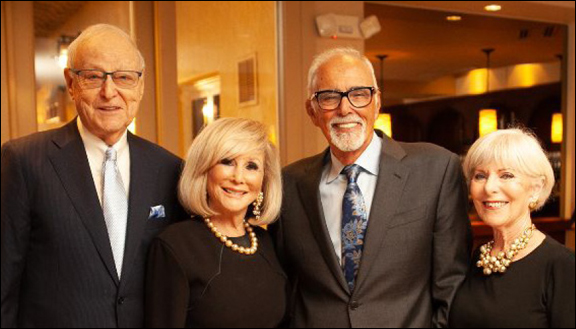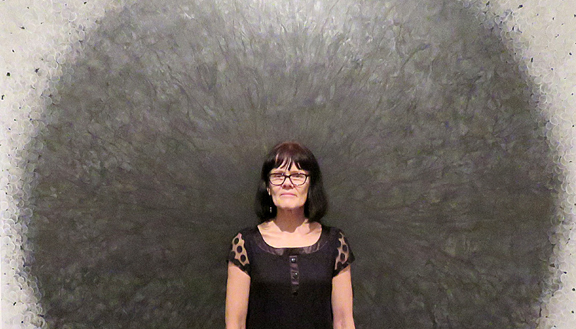 Artist Carol Prusa stands in front of “Dark Light, Elegy for Rebecca Elson.”
Artist Carol Prusa stands in front of “Dark Light, Elegy for Rebecca Elson.”By Rachel Galvin
Light and its absence are at the heart of Carol Prusa’s latest exhibit at the Boca Raton Museum of Art. What lies within the void is the question… what possibility lurks outside of the reach of mind’s eye? What was there before the beginning of the universe? Finding the answers to these questions certainly were within the mind of Prusa as she was creating her works with painstaking precision. Her artwork utilizes details, lines, shapes and symmetry to explore the abstract. Her “Dark Light” exhibition, which opened Aug. 20 and will be on display until Jan. 19, 2020, centers around her experiences of an eclipse.
“I got to experience the night during the day. The first was in Nebraska in 2017. It was so unsettling, so otherworldly. I had to try to grasp what I had just experienced. It knocked me backward. I had to lose my grounding. I had to try to express it the best way I could. I just went again in July 2019 to Chile. I had to see it again, to see if what I thought I saw, I saw,” said Prusa, who is now hoping to experience volcanoes. She has applied to do so at the Hawaii National Volcano Park, where they have just reopened residency.
When not creating works of art about the cosmos, she is reading about women who explored the cosmos in other ways, astronauts who have made vast discoveries, women like Maria Mitchell, who was not only the first female astronomer but the first scientist to discover a comet, among other accomplishments. Mitchell also seemed enamored with eclipses, as she led an all female expedition to Colorado in 1878 to observe one.
“I read a lot of cosmology and physics, big ideas that totally blow my mind,” said Prusa, adding that she likes to explore ideas like what was before the Big Bang, as well as string theory and more.
“It has to be that I don’t understand and then try to understand,” she said. “I need a catalyst to trigger …”
She added, “I love riding a bike at night. You think you see things. It is your mind buzzing, trying to fill the blanks. It is mind blowing. I think artists already are staring into darkness, scientists too.”
She was in Italy teaching drawing classes, and, while at the Uffizi Museum, she got to see drawings done with a process called Silverpoint, which she then began teaching her students and incorporated into her own work. She also uses graphite and acrylic working on plexiglass and wood panels. Some of her pieces in the museum exhibit are lit from within and one, called “Quintessence,” even has video, looking a bit like a kaleidoscope. The most imposing piece is a large scale work called “Dark Light, Elegy for Rebecca Elson,” who was a theoretical astrophysicist whose research focused on dark matter and who died of lymphoma.
With her “Cosmic Web (for the Harvard Observatory Computers)” piece, you feel like you are on the outside looking in.
She explained, “The perimeter is biological, a portal to the universe,” she said, adding that what looks a bit like brain matter around the edge was meant to look like “embryos before they are differentiated by gender. They are pure possibility.”
The “computers” of which she speaks are a group of female astronomers in the 1800s and 1900s who helped map the universe, including Henrietta Swan Leavitt, Annie Jump Cannon and Cecilia Payne-Gaposchkin.
She also has a series of smaller copperplate etchings honoring women astronomers, including Maria Mitchell, Henrietta Swan Leavitt, Annie Jump Cannon, Cecilia Payne-Gaposchkin, Vera Rubin and Jocelyn Bell Burnell. The portfolio is called “Galaxias Kyklos,” which means “Milky Path” (or Milky Way) in Greek.
Kathleen Goncharov, the Senior Curator of the Museum, curated the exhibit. If it were up to Prusa, her pieces would be logical, perhaps chronological and certainly lined up. But the curator thought about it differently, said Prusa, looking more at the visual impact experienced by the viewer.
Executive Director Irvin Lippman feels the exhibit came together in the perfect way at the perfect time, being that it deals with the cosmos just in time for the 50th anniversary of the moon landing.
“How timely … with the eclipse with the 50th anniversary of the moon landing. It is a bit of serendipity. We are also keen in the educational department to talk about the value of STEAM (science, Technology, Engineering, Art & Math). Carol makes the best argument for arts and technology coming together. She is a brilliant example of the scientific mind and creativity coming together.”
He added, “The museum was founded by artists and it’s very important to continue to have exhibits that celebrate Florida artists. Carol has been so involved for many years judging juried shows, at the museum and art school. It is important to show her work.”
While looking over the collection of her artwork, Lippman said, “When you approach it, it’s so meditative. When an eclipse happens, everything else falls by the wayside. They last only a few moments, but, during those moments, everyone focuses together. [The center point of her pieces] draw you inside. [It has] almost meditative spots.”
This is the first solo show here for Prusa, but she has been involved in group shows here in the past, as well as elsewhere. She will be shown in the Norton Sculpture Garden next fall and has a show in Taipei in a couple of weeks. She is in many galleries and is represented in Asia, Canada, Europe and the United States.
She lives here in Boca Raton, but moved here in 1999 from the midwest after reading an article written by Bernice Steinbaum, who said that South Florida was the place to be for the art world.
 “Cosmic Web (for the Harvard Observatory Computers)” by Carol Prusa. Submitted photo.
“Cosmic Web (for the Harvard Observatory Computers)” by Carol Prusa. Submitted photo.
Asked if she felt that Steinbaum was correct, she said, “I felt more
opportunity than in the midwest. There is more money to support art in
South Florida. But it was more commercial than I understood … that was
a transition. I think I have done well. I feel fortunate.”
Prusa wasn’t always an artist.
“I
was the president of the math club and a chemistry major. I was happy. I
met an artist at the University of Illinois. She thought in such a
different way. I thought I could not become a complete person unless I
studied art,” said Prusa, who received her Bachelor’s of Science from
the University of Illinois and her Masters of Fine Art from Drake
University.
She ended up obtaining a
biomedical communications degree. She became a Medical Illustrator,
which combines science and art. She was qualified to “make life masks,
prosthetics, exhibition design, anatomy drawings” and more.
Her
family was not so thrilled with her career path. She came from a very
religious and iconoclast upbringing. Her father was a Calvinist, a head
elder. She said she felt that tradition did give her “great rigor,”
which she applied to her career, as she explored other ways of thinking
than those she knew.
These days, Prusa does her work in her studio but it was not always the case.
“I
used to work in my living room. Now, I have a 15 x 30 studio built in
the backyard,” she said, saying she built the studio after winning the
South Florida Cultural Consortium $15,000 top prize in 2003. She later
received another consortium prize for $7500.
When working on her pieces, she likes to listen to NPR.
“It
takes a piece of my mind away so my mind can be more Zen. The
judgmental and critical mind drops away and is given over to NPR.”
When
not working on her works of art, Prusa is a professor at the Florida
Atlantic University teaching all levels of painting for undergraduate
and graduate level. She has worked there for 19 years, but worked for 18
years prior teaching at Iowa State University. She has a husband and
two children.
The Boca Raton Museum
of Art is located within Mizner Park at 501 Plaza Real in Boca Raton.
For more information on the museum, visit www.bocamuseum.org or call
561-392-2500. For more information on the artist, visit
www.carolprusa.com.
 Guests attend opening of the “Dark Light” exhibit on Aug. 20.
Guests attend opening of the “Dark Light” exhibit on Aug. 20.















